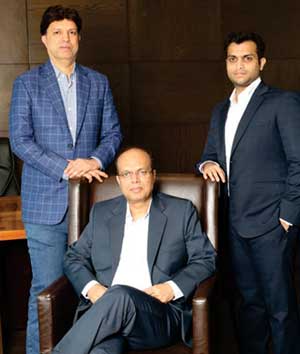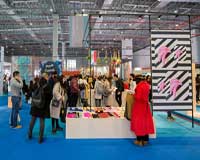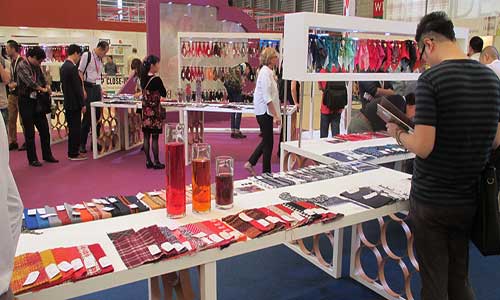FW
India’s cotton production may rise 12 per cent during 2017-18. Export of raw cotton from India has witnessed a significant increase in recent years along with decreased cotton imports into the nation. The country is now the second largest textile and clothing exporter in the world, contributing around five per cent to the global textile and clothing trade.
As Chinese cotton auction started at a 25 per cent premium over prevailing fiber rate in India, Indian exporters are hoping for a revival in cotton yarn exports. The Indian textile industry is estimating cotton production at 380 million bales against 340 million bales produced last year.
India is emerging a favorable destination for Latin American countries as they want to reduce their dependence on Chinese markets for imports and are looking towards diversifying their markets. During April-December 2016, India’s cotton yarn exports slumped by 12 per cent. During the last 16 years, the area under cotton production has doubled with about 10 million farmers producing cotton in India. However, though the country produces good quality cotton, it is sold at a discounted price because of unwanted constituents and contaminants. The textile industry will use biotech and better irrigation and mechanization.
In 2013-2014, India had overtaken Italy and Germany and become the second largest textile exporter in the world. However, there has been a downslide since then. Overall export of cotton textiles has declined by over 30 per cent in the past three years. The volume of cotton yarn exports declined 15 per cent from 2015 to 2016. Other textiles (yarn, fabric, made up articles) declined by 10 per cent during 2014-15. Raw cotton (including waste) recorded an overall decline of 14 per cent. Cotton fabrics recorded an overall decline of five per cent. This decline is expected to add to the existing distress in the economy.
Cotton textiles comprise cotton yarn, other textile yarn, fabrics, made-up articles, cotton raw waste and cotton fabrics and made-ups, which include products like bed sheets, blankets and curtains. Export of cotton at present is under the open general license. India ranks among the largest producers and exporters of cotton textile products. India exports cotton textiles to Russia, UK, Australia, Sri Lanka, Iran, Germany, Belgium, Italy etc.
The cotton textile industry in India faces numerous problems. Some of these are: Long staple cotton is grown much in India. Many factories are old and productivity is lowered.
The cultivation of genetically modified (GM) crops with new transgenic traits such as herbicide tolerance (HT) is spreading fast in cotton growing states in India even though no license or approval has been granted for growing them in India.
Farmers are swayed by the multiple benefits of these GM varieties, which are being sold illegally, as they offer the twin advantage of bollworm resistance and herbicide tolerance. In comparison, the approved Bt variety (Bollgard I and Bollgard II) is only bollworm-resistant.
The new GM varieties are being sold at half the price of approved hybrid cotton seeds by the grey market players, who seem to be outsmarting regulatory officials by operating directly in remote parts without any valid licenses.
Farmers often keep the information under wraps fearing that they could be sent to jail if they are found cultivating the illegal GM cotton varieties. It is estimated that the unapproved transgenic cotton seed varieties that carry a combination of HT and IT (insect tolerant) traits are being cultivated in about 15 to 20 per cent of the total cotton crop area in the country.
Cultivation of these GM cotton hybrids is happening in all the major cotton growing states. To that extent the cotton seed market has shrunk for the licensed seed companies.
Benetton is not yet back on track but is pursuing its investment plan. The clothing group has struggled to take off despite its reorganization that began in 2015, which saw the company refocus on its two main brands, United Colors of Benetton and Sisley, by completely changing its structure.
Benetton nearly doubled its net loss from €46 million in 2015 to €81 million a year later, while it recorded an operating loss of €38 million compared to €19 million the previous year. The results were published in Edizione’s 2016 balance sheet, the holding company which controls 100 per cent of Benetton and the empire of the eponymous family. In 2016, Benetton Group suffered from continued economic stagnation in Europe, with a deterioration in sales and profitability which resulted in a weakening of its financial position. Cash flow went from €85 to €24 million in one year.
According to the textile group it has not slowed down its ongoing transformation projects or its investment plan, and is on track to achieve them as planned without falling into debt. Moreover, Benetton accelerated its investments last year, since they increased by 39.2 per cent compared to 2015, reaching €45 million. Nearly 330 outlets were opened or repositioned in 2016.
Shirts, trousers, jackets, T-shirts and sweaters contribute 75 per cent to Bangladesh’s apparel exports. But during the last fiscal only the sweater segment maintained an upward trend in earnings. Earnings grew by 5.62 per cent. Earnings from shirts declined nine per cent, trousers fell by 4.62 per cent, jackets fell by 6.02 per cent and T-shirts fell by 4.19 per cent.
Among the reasons for the fall in exports are rising production costs, currency fluctuation and a decline in global demand. But a critical factor is sweater units are automated. Prices of sweaters dropped and customers placed more orders in the jacquard category. An automated jacquard machine is not only able to produce diversified and fashionable products, but can also fabricate critical designs.
As for other categories like shirts and T-shirts, they were already competitive and therefore there was no further margin to compromise on.
Bangladesh has more than 500 sweater factories in operation and nearly 60 per cent of these have switched over to automation to ramp up productivity. A manual machine with one operator can produce a maximum of five pieces a day. An automatic machine with one operator can produce about 30 pieces a day. Many owners have opted for automatic machines to remain cost competitive in the long run.

Donear has acquired Grasim Bhiwani Textiles. The acquisition will give the Donear Group world class manufacturing capabilities, an iconic fabric brand and access to marquee customers globally. It will significantly enhance Donear’s product portfolio, give it access to a strong nationwide retail network, wholesalers and multi-brand outlets through which Donear can expand its reach.

Grasim is the country’s largest manufacturer of PV and PW suiting, selling its products under the Grasim and Graviera brands in India and abroad. The biggest strengths of Grasim Bhiwani are its quality-conscious trade partners and global customers, who have been associated with it for a long time.
Grasim Bhiwani caters to international fashion houses in the US and the UK, supplying fabric to them for making garments. These garments are available in some of the largest retail chain stores. Donear aims to build further on Grasim’s existing strengths. Both Donear and Grasim Bhiwani will maintain their individual identities and stay committed to offer the best products and services to their valued customers as one team.
Textile is Donear’s core business. It has a production capacity of around 45 lakh meters a month. Donear also has a strong international presence. With a comprehensive product basket, the company is supplies fabrics to India’s largest brands including Louis Philippe, Van Heusen, Peter England, Blackberry, Arvind, Wills Lifestyle and more.
Only job workers or units with an annual turnover of Rs 20 lakh or more, need to register for GST. However, the textile industry, especially the power loom segment, is not impressed. There are a large number of small job workers with an annual turnover of less than Rs 20 lakh, whom the power loom industry, especially master weavers, has to engage. With exemption from GST registration, master weavers would end up with the reserve charge mechanism.
In other words, master weavers would have to pay duty on behalf of job workers. Decentralised units employ job workers’ services for weaving and embroidery work, which attracts GST at 18 per cent. Units in the powerloom sector feel they should have been given time to first come under formal taxation net before being subject to any duty.
The powerloom sector is also padding up for a double whammy. Much of the yarn twisting and embroidery work is done by women from their homes but labor, which along with power accounts for 80 per cent of input, is not under the input credit net in the GST regime. This would deprive power loom owners of a refund.
The global silk market is projected to grow at a CAGR of 7.8 per cent from 2016 to 2021. Growth can be attributed to technological advancements in sericulture, which directly increases the yield of silk. Moreover silk is a low capital investment industry in terms of technology and labor.
Though demand for silk products is growing in Europe and North America, the Asia-Pacific region is the largest market for silk. It has a large number of textile manufacturers and growing demand from the domestic market. China dominates the silk market in the Asia-Pacific region followed by India. Raw silk is easily available in the two countries. China is the largest producer of silk yarn and textile products. The Asia-Pacific region remains the fastest growing market for silk in terms of value and volume.
Based on type, the mulberry silk segment is projected to lead the silk market. Owing to its high strength, durability, and flexibility, mulberry silk is used in the production of textiles such as apparel, wedding dresses, gowns etc as well as in interiors such as pillows, wall hangings, and upholstery. The growing textile industry in the Asia-Pacific region is driving the demand for mulberry silk in the region.
Abercrombie & Fitch has been changing its image amid a challenging retail market. In 2014, it did away with its iconic moose logo. And in July this year, the brand removed its signature scent from its stores. Instead shoppers will be greeted with the smell of a gender-neutral fragrance that is more in keeping with the current predilection for gender-neutral or unisex fashion.
For the first time in 15 years, the brand has completely updated its jeans line. The new denim line utilizes latest technology and fabrication, including a 360-degree stretch. One of the most obvious changes from Abercrombie’s previous denim offerings is the absence of the brand’s distinctive stitching on the back pockets. The women’s line will have sustainable denim. These styles use less water to achieve the desired wash.
The changes come as a difficult retail market has forced many retailers to shut stores or declare bankruptcy in the past few years. Among those are brands with a strong presence in malls and following among teens such as True Religion, Rue21 and Aeropostale.
Despite the difficult market, Abercrombie’s design process remains focused on the clothes rather than the finances. It’s focused on making an exceptional product at an exceptional value and offering the ultimate casual luxury brand experience.
"As the global apparel fabrics and accessories industry prepares to gather in Shanghai from October 11-13 for Intertextile Shanghai Apparel Fabrics – with suppliers from 25-plus countries and trade buyers from around 100 countries – exhibitors are gearing up for yet another edition of strong results. Occurring towards the end of the autumn/winter sourcing period, buyers come to the fair well informed of next season’s trends, and are in a position to be able to make their purchasing decisions from the around 4,500 exhibitors that will be present."

As the global apparel fabrics and accessories industry prepares to gather in Shanghai from October 11-13 for Intertextile Shanghai Apparel Fabrics – with suppliers from 25-plus countries and trade buyers from around 100 countries – exhibitors are gearing up for yet another edition of strong results. Occurring towards the end of the autumn/winter sourcing period, buyers come to the fair well informed of next season’s trends, and are in a position to be able to make their purchasing decisions from the around 4,500 exhibitors that will be present.

With fast paced changes both in national economies and the apparel fabrics and accessories industry, the number of trade buyers at the fair – around 70,000 – and their diversity – some 100 countries – presents an unrivalled opportunity for exhibitors to find new markets, or double-down on existing ones. This diversity is further shown in buyers’ product sourcing preferences at the fair. Last year, buyers’ main area of sourcing interest for all eight main fabric product categories was between 11 per cent and 38 per cent, reflecting a relatively even spread across all types of fabrics.
Innovation at its best
While Intertextile Shanghai is well-known for its exhibitor and product breadth, buyers in the know also use it as a sourcing platform for latest functional apparel fabric innovations. The fair’s Functional Lab, which will feature around 50 exhibitors this edition is the centre of innovation at Intertextile, featuring a wide selection of innovative yarns and fibres, fabrics, accessories, finishes and coatings, membranes and more, particularly for athleisure, sports and outdoor wear, as well as lingerie. Buyers looking for eco-friendly options can find plenty to choose from in this zone as well.
For instance, Aquafil, an Italian firm will showcase its Dryarn® fibre at the fair; what they claim is the lightest fibre in the natural world. Garments made of Dryarn® weigh 32 per cent less than an equivalent garment made of wool, and 34 per cent less than one of polyester. Moreover, it offers high levels of thermal comfort and breathability which makes it ideal for a wide range of uses including fashion, and sports and outdoor wear.
Belgium’s Vetex, specialists in coatings and laminations for various textiles, won an award at the recent Techtextil fair in Frankfurt for their ecologically-friendly solution to replace dimethyl formamide (DMF) as a solvent in PU coatings. At Intertextile Shanghai, they will present their seam seal tapes which are fixed to shoes, garments and outdoor products through a unique hot air process (seam sealing), an innovative technology that ensures they retain their specific properties during the manufacturing process. They will also showcase their laminates for the medical industry at the fair.
The Chemours Company will showcase Teflon EcoElite™ durable water repellent (DWR), which is a highly sustainable, renewably sourced, non-fluorinated treatment for fabrics. It contains 63 per cent renewably sourced content, is up to three times more durable than existing non-fluorinated repellents, and has high water repellency for at least 30 washes.
Expanded Taiwan Pavilion at Functional Lab
In addition to the expanded Taiwan Pavilion inside the Functional Lab (hall 5.2), a number of innovative products will also be on offer in the main Taiwan Pavilion in hall 6.2. For example, Kong You Industrial will feature a new technology at the fair – a waterproof, microporous PU membrane with enhanced breathability due a special four-way stretch technology employed during the melt extrusion process of the knitted fabric and PU membrane. Sheng Ye will showcase their new generation, eco-friendly, lightweight composite fabric. This fabric also contains a special high-tech film with pores that are extremely small and have an irregular curved arrangement, giving it a high permeability and resistance to water pressure. PFC-free, it is also biodegradable. This fabric is suited to outdoor wear and outdoor supplies.
Along with Intertextile Shanghai Apparel Fabrics, three other textile fairs are held concurrently: Yarn Expo Autumn (hall 5.1), CHIC (halls 2 & 3) and PH Value (hall 3). Intertextile Shanghai Apparel Fabrics – Autumn edition 2017 is co-organised by Messe Frankfurt (HK) Ltd; the Sub-Council of Textile Industry, CCPIT; and the China Textile Information Centre.












